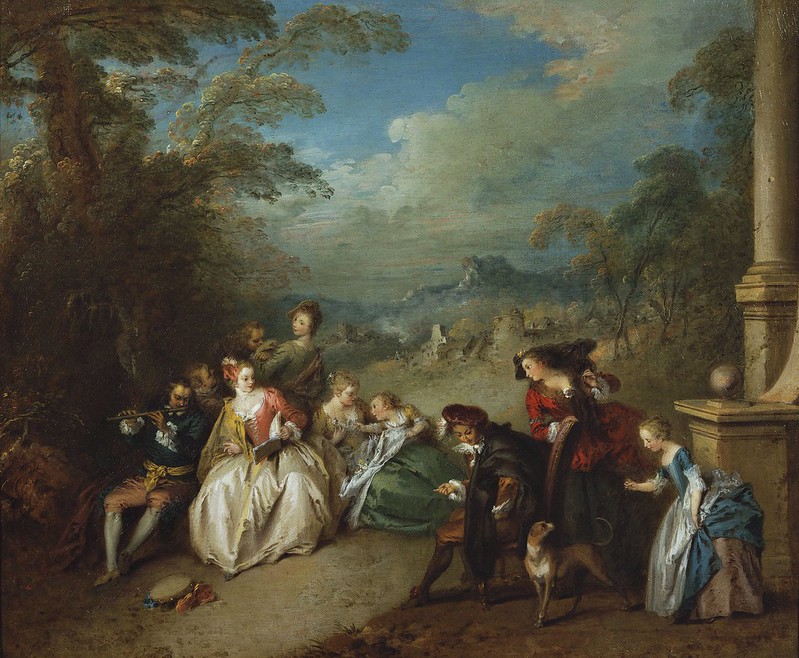Henri-Jacques de Croes (1705-1786)
- Concerto 6.o per Flauto Traverso (1737)
Performers: André Isselee (flute); Les Solistes De Liège; Géry Lemaire (conductor)
Further info: Henri-Jacques de Croes (1705-1786) - Confitemini Domino
---
Flemish composer, conductor and violinist. At the age of 18 (7 November
1723) he was named first violin at the St Jacobskerk, Antwerp. In
September 1729 he went to Brussels, where he entered the service of
Prince Anselme-François of Thurn and Taxis. The prince held the monopoly
of postal services in the Empire and had several residences, the most
important being at Brussels and Frankfurt and later at Regensburg; de
Croes is mentioned in the prince’s archives in Germany (in 1734, 1737-39
and 1742). By 1744 he was back in Brussels as a first violin in the
chapel of Charles of Lorraine, whose sister-in-law, the Empress Maria
Theresa, had made him governor of the Austrian Netherlands. In 1746 he
became maître de chapelle at the court and directed the chamber music,
for at that time the same musicians played in both chapel and court.
There were six singers (two counter-tenors, two tenors and two basses)
and 13 instrumentalists (six violinists, one violist, one cellist, one
double bass player, two organists and two oboists), all of whom were
French. For important festivals, the orchestra was augmented by the
musicians of the most important collegiate church in Brussels, Ste
Gudule (now the cathedral). De Croes remained master of music at the
Brussels court until his death. Given de Croes’s circumstances, it is
not surprising that he composed both church music and chamber music (in
particular sonatas and concertos). He was in no way an innovator: his
style may be described as an interweaving of the French and Italian
traditions, as might be expected in the South Netherlands at a time when
musical forms were in a stage of transition between the Baroque style
and the galant. In his trio sonatas, for example, he wrote in the
Corelli tradition with a slow introduction and fugal allegro followed by
a number of movements alternately slow and fast.
In other sonatas he conformed to a more modern Italian pattern:
fast–slow–fast, with a lighter texture and more ornate melodic lines.
The divertissements belong to the tradition of the French suite, with an
overture in dotted rhythm followed by dances. As in the Italianate
sonatas, the texture is light and the decoration combines French
ornaments with new fashions like the ‘Mannheimer Vorhalt’ and the
Lombard rhythms common in contemporary German music. The solo concertos
and the concerti grossi are in the contemporary three-movement Italian
style but with the lighter texture that was then employed in France
after the manner of J.-M. Leclair; the trademarks of the Mannheim school
are also present, giving the concertos a pre-Classical accent. De Croes
was influenced by Corelli, Vivaldi, Tartini and even Handel, and his
opening themes frequently bear close resemblance to their works. De
Croes’s extant church music includes several motets and fragments of
masses, written for four voices and four instruments, with the usual
tessituras; this was doubtless the force of the royal chapel and Ste
Gudule. Despite the requirements of church music (particularly the
masses), the idiom seems more instrumental than vocal. The instruments
frequently double the voice parts or realize the figured bass in a
fairly straightforward manner. The motets are unusual in that they have a
structure similar to that of the cantata, with alternating choruses and
solo sections. In these works too, there is evidence of French
influence (particularly of a tradition founded by Henry Dumont at the
court of Louis XIV), combined with the traditions of the Italian
cantata. De Croes’s son, Henri-Joseph de Croes (1758-1842), was from
1775 a violinist in the service of the Prince of Thurn and Taxis at
Regensburg, and maître de chapelle from 1776 to 1783. He is known to
have composed only one work, a set of violin duos which his father
presented to Charles of Lorraine in the (unfulfilled) hope that his son
might succeed him as maître de chapelle at the Brussels court.

Cap comentari:
Publica un comentari a l'entrada